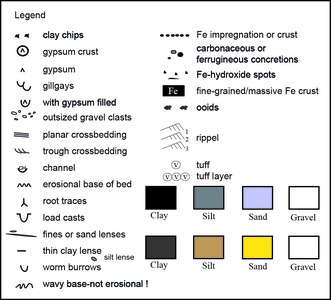Hornung, Jens ; Hinderer, Matthias ; Brüsch, Dennis ; Petschick, Rainer (2023)
An exceptional sedimentary record of initial rifting on the East African Plateau in the Miocene: Lessons from depositional cyclicity and palaeoenvironmental proxies.
In: The Depositional Record, 2022, 9 (1)
doi: 10.26083/tuprints-00023723
Article, Secondary publication, Publisher's Version
|
Text
DEP2_DEP2207.pdf Copyright Information: CC BY 4.0 International - Creative Commons, Attribution. Download (53MB) |
||
|
Text
(Supplement)
dep2207-sup-0001-appendix.pdf Copyright Information: CC BY 4.0 International - Creative Commons, Attribution. Download (62MB) |
||
![[img]](https://tuprints.ulb.tu-darmstadt.de/23723/4.hassmallThumbnailVersion/dep2207-sup-0002-legend4roadcutsections.jpg)
|
Image
(Supplement)
dep2207-sup-0002-legend4roadcutsections.jpg Copyright Information: CC BY 4.0 International - Creative Commons, Attribution. Download (910kB) | Preview |
| Item Type: | Article |
|---|---|
| Type of entry: | Secondary publication |
| Title: | An exceptional sedimentary record of initial rifting on the East African Plateau in the Miocene: Lessons from depositional cyclicity and palaeoenvironmental proxies |
| Language: | English |
| Date: | 26 May 2023 |
| Place of Publication: | Darmstadt |
| Year of primary publication: | 2022 |
| Publisher: | John Wiley & Sons |
| Journal or Publication Title: | The Depositional Record |
| Volume of the journal: | 9 |
| Issue Number: | 1 |
| DOI: | 10.26083/tuprints-00023723 |
| Corresponding Links: | |
| Origin: | Secondary publication DeepGreen |
| Abstract: | Knowledge about the initial tectonic and depositional dynamics, as well as the influence of early rifting on climate and environmental evolution remains speculative to a large extent, because sediments are usually deeply buried. Within the East African Rift System, inversion tectonics uplifted a few of these successions to the surface hence presenting rare windows into the pre‐rift depositional history. One such example, an exceptional 700 m long and up to 60 m high fresh road cut provided the opportunity to study in detail initial rift successions of the southern Albertine Rift (Western Uganda). This focusses on the basal and poorly known Middle to Late Miocene in order to unravel the climatic, environmental, hydrological and tectonic evolution of the initial Albertine Rift. A large and robust multi‐proxy dataset was gathered comprising 169 m of stratigraphic thickness, which spans from 14.5 to 4.9 Ma according to a revised lithostratigraphic model. Fieldwork comprised logging of the sedimentary record, spectral gamma ray, magnetic susceptibility and 2D wall mapping with photomosaics. Additionally, the sections were sampled for bulk mineral and clay mineral analysis. The succession exposes a suite of lithofacies and architectural elements detailing the evolution of a fluvio‐lacustrine system. Five depositional environments were identified which show an overall back‐stepping trend from an alluvial plain to a delta plain and finally palustrine/shallow lacustrine conditions. Mesoscale base‐level cycles, preservation potential of architectural elements, and stacking pattern exhibit limited accommodation space. However, it increases over time. This overall trend indicates increasing tectonic subsidence, which can be explained by flexural downwarp within the pre‐rift phase and in the upper part grading into fault‐controlled crustal extension of the syn‐rift phase, which more and more disrupted a large‐scale river system. From the Middle Miocene up to the early Pliocene, this study revealed that palaeoclimate trends become marked by increasing and more fluctuating Th concentrations, loss of feldspar, intercalated lenses of hydroxosulphate minerals, and a shift from smectite‐dominated to kaolinite‐dominated clays. These signals are all interpreted as detrital except for the hydroxosulphates, and they mirror the increasing intensity of chemical weathering and stripping of soils in the catchment. A trend towards increasing humidity is supported by an increase in lacustrine sediment facies and a lake‐level rise. Nevertheless, intercalation of hydroxosulphate, ferricretes and pedogenised horizons prove ongoing seasonality and dry intervals. Finally, based on a revised stratigraphic model a sequence stratigraphic correlation of the outcrop's depositional cycles with basin‐scale cycles is presented. According to these cycles, transition from the pre‐rift to the syn‐rift stage is marked by an unconformity and a tectonic pulse in the latest Miocene. However, the response of fluvial supply, the depositional system as well as climate conditions are less punctuated and characterised by gradual trends and temporal delays. The long pre‐rift phase (ca 10 Myr) and the gradual transition to the syn‐rift phase is in accordance with the active rifting model, which is based on thermal thinning of the lithosphere by asthenospheric upwelling. |
| Uncontrolled Keywords: | Albertine rift, base‐level, clay mineralogy, depositional cyclicity, EARS, gamma‐ray, hydroxosulphate, magnetic susceptibility, palaeoclimate, sedimentology, sequence stratigraphy, thorium |
| Status: | Publisher's Version |
| URN: | urn:nbn:de:tuda-tuprints-237239 |
| Classification DDC: | 500 Science and mathematics > 550 Earth sciences and geology |
| Divisions: | 11 Department of Materials and Earth Sciences > Earth Science |
| Date Deposited: | 26 May 2023 11:55 |
| Last Modified: | 29 Sep 2023 07:45 |
| SWORD Depositor: | Deep Green |
| URI: | https://tuprints.ulb.tu-darmstadt.de/id/eprint/23723 |
| PPN: | 511960751 |
| Export: |
 |
View Item |



 Drucken
Drucken
 Impressum
Impressum